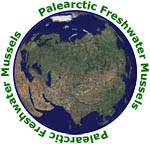| Page last updated
27 December 2007 |
Palearctic Freshwater Mussels
The following pages on the taxonomy of the Palearcitc freshwater mussel assemblage are based on the following article:
- Graf, D.L. 2007. Palearctic freshwater mussel (Mollusca: Bivalvia: Unionoida) diversity and the Comparatory Method as a species concept. Proceedings of the Academy of Natural Sciences of Philadelphia 156: 71-88.
 The freshwater mussel assemblage of the Palearctic is not particularly diverse, relative to other areas of the world. The Palearctic is the name for the temperate areas of Eurasia, stretching from western Europe and the Atlantic to Siberia, Japan and the Pacific. The species of the region express the same patterns of morphological variation across their ranges, and the challenge of sorting out those taxonomic issues is further compounded by the scientific/cultural differences expressed by malacologists since Linnaeus introduced the first four species to be formally recognized in Europe in 1758. Since that time, many hundreds of species and subspecies have been described, but the current consensus among most freshwater malacologists is that there are 45 Palearctic freshwater mussel species. That assessment is complicated by the use of the "Comparatory" or "Comparatorial" method in eastern Russia, which drastically inflates diversity estimates when compared to those estimated for Biological species. Using the Comparatory Method, the Palearctic diversity could be as high as 156 "species". The freshwater mussel assemblage of the Palearctic is not particularly diverse, relative to other areas of the world. The Palearctic is the name for the temperate areas of Eurasia, stretching from western Europe and the Atlantic to Siberia, Japan and the Pacific. The species of the region express the same patterns of morphological variation across their ranges, and the challenge of sorting out those taxonomic issues is further compounded by the scientific/cultural differences expressed by malacologists since Linnaeus introduced the first four species to be formally recognized in Europe in 1758. Since that time, many hundreds of species and subspecies have been described, but the current consensus among most freshwater malacologists is that there are 45 Palearctic freshwater mussel species. That assessment is complicated by the use of the "Comparatory" or "Comparatorial" method in eastern Russia, which drastically inflates diversity estimates when compared to those estimated for Biological species. Using the Comparatory Method, the Palearctic diversity could be as high as 156 "species".
Palearctic Region and Four Subregions
We divide the Palearctic into four subregions, corresponding to areas of endemism of freshwater mussel species and genera.

The Palearctic Region and its four subregions: West, Southwest, East and Central.
The Western Subregion extends from the UK and western Europe to the Ural Mountains and the eastern extent of the Black Sea Basin, including the Maghreb of northern Africa. The Southwest from the Tigris-Euphrates Basins in Iraq and western Iran, west to the Levant. The Nile Basin, in northeastern Africa, might also be considered to be a part of the Southwestern Palearctic, but except for only two species, the rivers fauna is decidedly Afrotropical. The Eastern Subregion includes the Amur Basin in eastern Russia, Korea, Japan, Sakhalin Island, and north through the Kurils to Kamchatka. The Central Subregion is an area of low diversity in Central Asia extending from east of the Urals to Lake Baikal. The northern limit of Palearctic freshwater mussel distributions is determined by the extent of suitable habitat. In the south, the boundary is basically determined by a band of deserts and mountains running from the Sahara east to the Gobi. In China, the southern limit of the Palearctic Region is pegged to the northern extent of the diverse Indotropical mussel assemblage.
Over the last 250 years, the science of taxonomy has evolved, and as a result, estimates of Palearctic freshwater mussel diversity have changed over time as well. In Europe, there has been a great reduction in the number of recognized species as malacologists adopted a Biological Species Concept. |